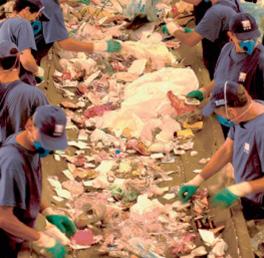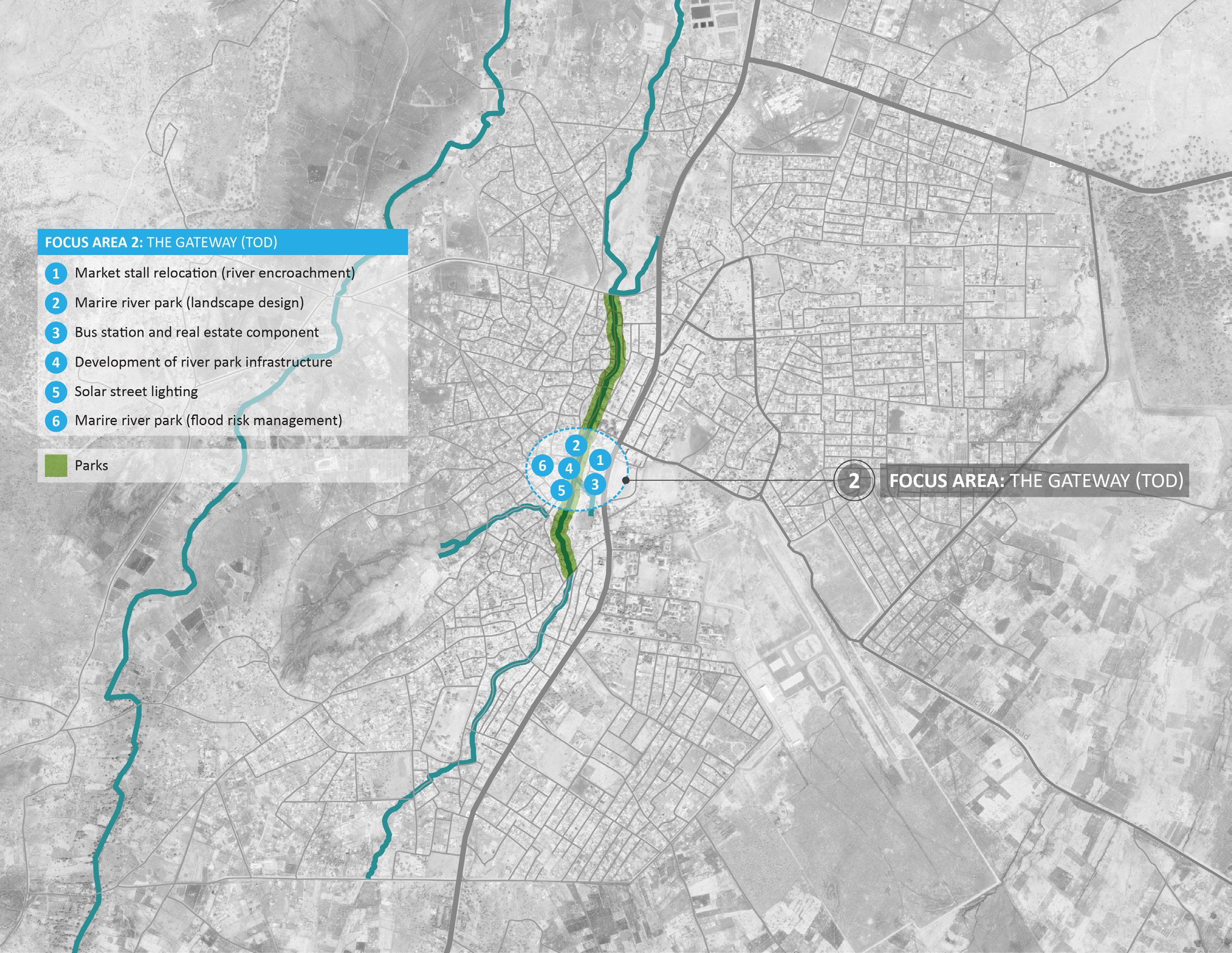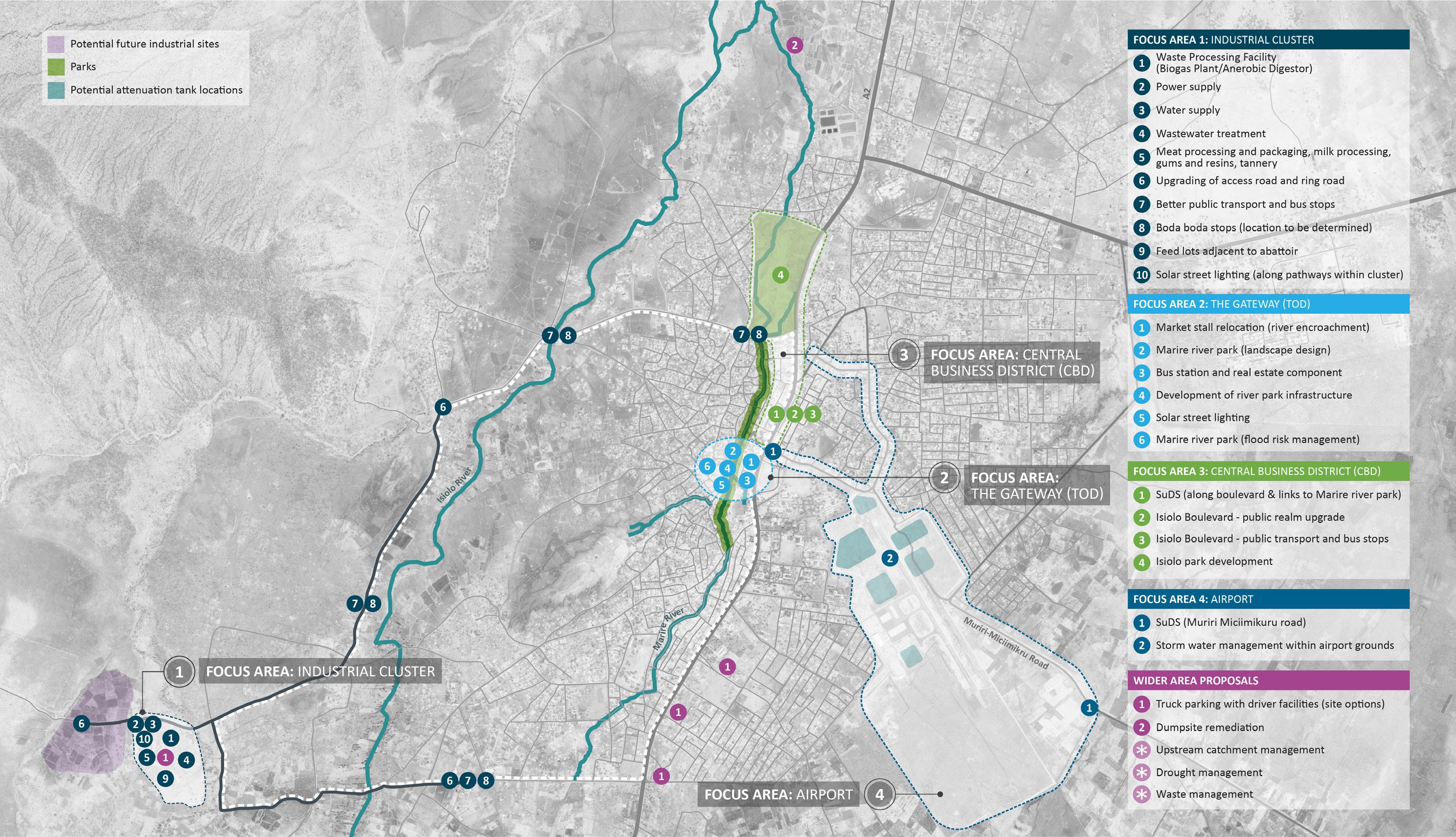
20 minute read
Wider Area Proposals
ECONOMIC DEVELOPMENT PLAN 80
The previous sections have considered and proposed climate resilient infrastructure projects which support the Town in its immediate needs whilst also supporting the proposed value chain and catalytic development opportunities that have been identified. This has been done through the development of an industrial cluster to introduce diversified manufacturing and processing capabilities to the Town’s economy, improvements in the Town’s entrance (gateway) and CBD, roads and storm water drainage infrastructure and the provision of enhanced public realm and pedestrian linkages. The following section outlines other broader based infrastructure projects which will assist with issues that are located in the wider hinterland of the Town or that impact the Town in some other way. Issues such as uncontrolled truck parking within the Town and CBD area, the unmanaged waste disposal and dumping to the north of the Town, the broader catchment management issues responding to both flooding and drought impacts, along with the provision of solar powered irrigation and water sourcing.
Figure 33 - Development Framework plan showing Wider Area Proposals
81 ISIOLO URBAN ECONOMIC PLAN
WIDER AREA PROPOSAL Truck Parking with Driver Facilities (Site Options) 1
There is a high-volume heavy goods vehicle that passes through the Town centre. Due to the lack of dedicated truck parking facilities, most of the service roads along the main corridor through the Town centre are being used by trucks for long-term parking. The urban development proposal for Isiolo is to develop the central spine of the Town centre, creating a vibrant pedestrian-friendly area. It proposes to remove long-term truck parking facilities from the service roads and provide sufficient short-term loading and unloading bays to support the local businesses. It is, therefore, essential to provide a dedicated long-term truck parking facility. The facility will need to provide appropriate amenities for the truck drivers and operators, including vehicle maintenance facilities, toilets, and shops. The map right presents the proposed location of the truck parking facility. The rationales for proposing the location are: › The location is no longer than 2km away from the city centre. A round trip from the parking area to the city centre would not cause major additional veh-km; › The location is less than 2km away from the airport; › The location is roughly 1km away from the proposed ring road. It would allow easy access for the goods vehicles entering Isiolo Town for the proposed industrial cluster; and › It has direct access to the A2 road that connects Isiolo with Nairobi on the south-western side.
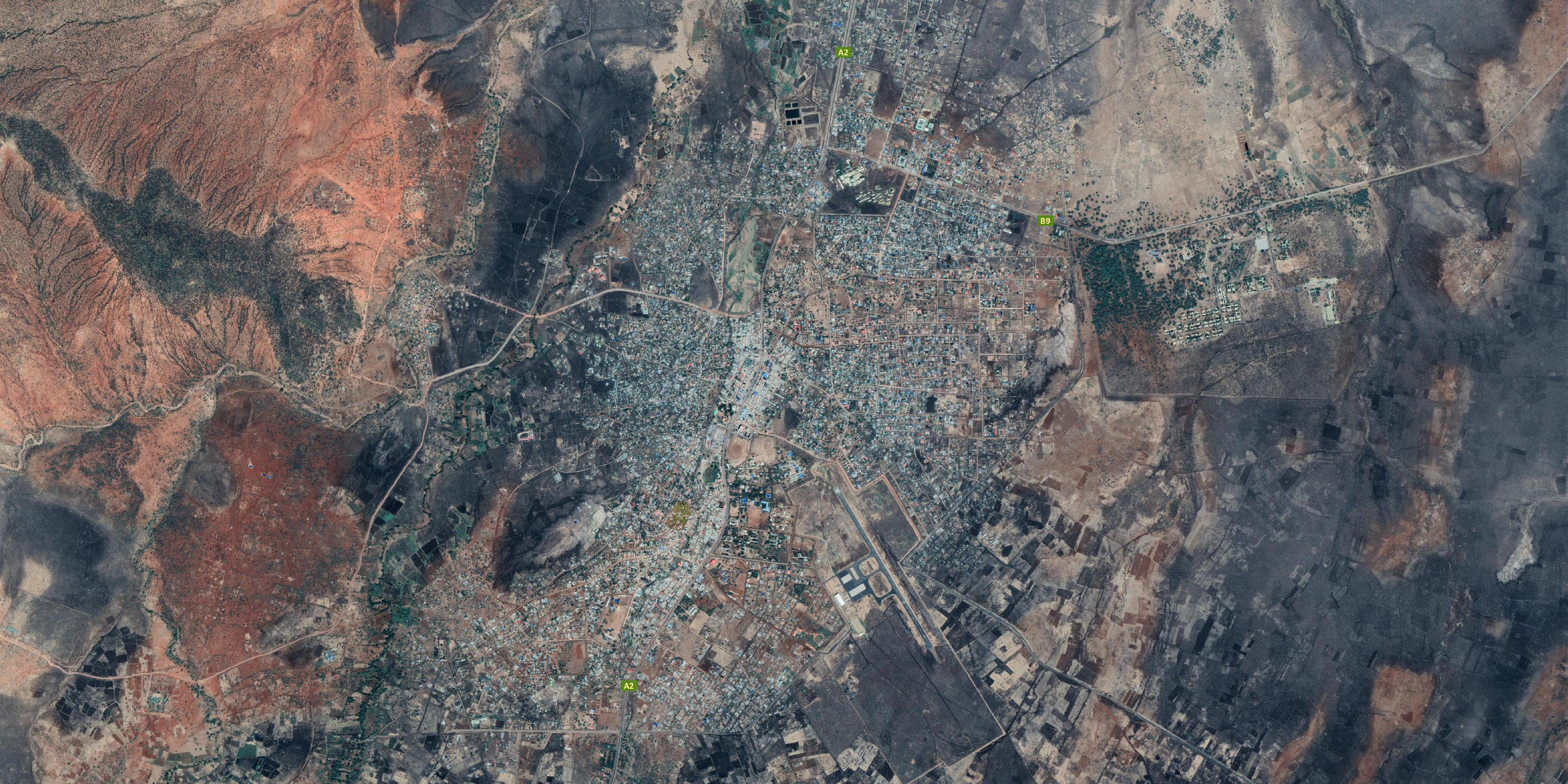
Sub-Components Estimated Cost Impacts (Benefits) Delivery Mechanisms Potential Funding
› Develop a truck terminal › Terminal amenities such as toilets, shops, vehicle maintenance facilities › (Cost of land acquisition not included) › CAPEX of developing truck terminal + amenities
KSh 150k - 200k per sqm › Annual OPEX of truck terminal 15k per sqm › Easy access to the industrial cluster › Ease road congestion at the Town centre › Improved road safety › Isiolo Municipal
Council › Public funding - potentially from
National government or international development partners › Alternatively, it has the potential for
PPP investment. The private sector would have the opportunity to recover their cost by charging parking fee to the truck operators Challenges
› May require land acquisition › Funding › Buy-in from the local stakeholders › Buy-in from the truck operators › Pre-feasibility and feasibility studies › Public consultation › Short to medium term
Data Gaps
Figure 34 - Truck Parking (potential site locations)
N
Road Upgrade
Op�on sites for truck parking Time Frame
A2
Isiolo Town
A2
WIDER AREA PROPOSAL Remediation of Existing Landfill 2
Remediation and engineering into a sanitary landfill of the existing dumpsite. › Determine level of investment and secure funding (IFI, grant, PPP or direct by government) › Appoint private contractors to remediate and clean the site › Engage with informal sector and CBOs Construct and install two barrier lining and leachate and landfill gas collection and treatment systems within the new engineered landfill cells.
Sub-Components Estimated Cost Impacts
› Construction of engineered landfill and excavation and haulage of existing dumped material into new cells › USD $1 million to USD $4 million › Funding: IFI /
Donor Finance › Improved ground and water quality › Reduces methane production in the landfill › Improves local air quality › Provides employment › Provision of a sanitary and engineered landfill for future management of residual waste › Opportunity for collaboration with private sector
Delivery Mechanisms ECONOMIC DEVELOPMENT PLAN 82
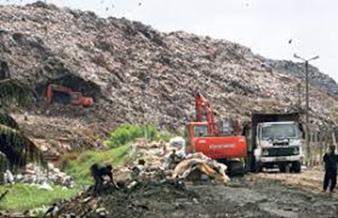
Challenges
› Isiolo has waste being dumped on the road verges, uncontrolled fires and pollution of surrounding water bodies. › No formal means of treating and disposing of waste. › Need to be mindful of employment and social impacts on informal sector that live and work on the existing dumpsite › Obtain funding for remediation infrastructure › Obtain funding for construction of new engineered landfill cells › Construction of new engineered landfill cells: Short-term › Removal of historical ‘dumped’ waste into new landfill cells:
Short-term › Construction of new concrete slab: Short-term
Data Gaps Time Frame
Case Study: Remediation of open dumpsites in South Asia (What a Waste 2.0, World Bank Group, 2018) Open dumping is common in South Asia with most open dumpsites lacking any form of leachate collection and treatment, landfill gas collection and many also lack any form of liner. However, the remediation of existing dumpsites and the construction of new engineered landfills is underway with the newer official and well operated landfills generally being privately operated. The Maldives is currently mitigating dumping of its waste by improving waste collection systems and constructing new engineered disposal sites that can serve a number of islands (World Bank 2017a).33
33 Waste Pickers Alliance, Uganda
83 ISIOLO URBAN ECONOMIC PLAN
WIDER AREA PROPOSAL Upstream Catchment Management
Catchment based initiatives use both land and water management to reduce the risk of flooding while aiming to balance environmental, economic and social demands to bring long-term improvements to the catchment.34 There are a number of catchment management options which would be appropriate for application in the upstream catchment in Meru county. These interventions have benefits for both Isiolo (downstream) and Meru and therefore promote collaboration between counties: › Storing more water: using the topographic characteristic of the land to position dams and irrigation areas creates more capacity to store water (key-line principle); › Planting trees and shrubs to reduce soil erosion and increases resistance to water flow; › Increasing soil infiltration: enhancing the soil structure to increase the levels of water that can be absorbed into the soil. This reduces the effects of drought as a result as healthy soils retain water for longer in dry periods; and › Intercepting rainfall: tree leaves intercept rainfall which then evaporates and reduces the amount of water that reaches the ground depending on the tree type. To the west of Isiolo Town centre natural flood management techniques and storage areas downstream of the hill could be used to intercept stormwater runoff and slowing the speed of water coming off the hill (see Figure 35).
Case Study:35
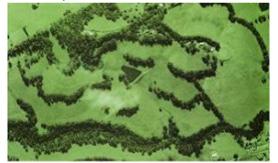
Photo of applied keyline Design at Nevallen Farm, Australia. By cultivating trees in parallel and upwards from any contour the project distributes water within the landscape reducing flooding downstream.
Figure 35 - Attenuation Pond

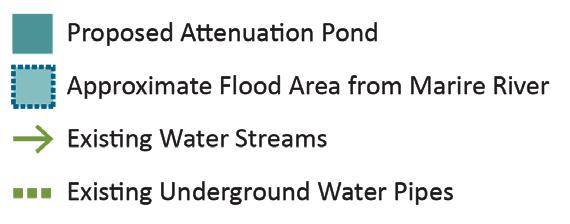
Drought management To complement Kenya’s drought monitoring programme, a three-pronged approach to drought risk mitigation is suggested: 1. Increasing supply (develop more water sources including reuse); 2. Reduce demand (reduce the amount of wasted water and water use - education); 3. Minimise the impact of drought (build resilience). Increase supply The development of new urban drinking water source in Isiolo is likely through new boreholes. A water resource and drought planning study would ensure that the most
34 http://www.fwr.org/WQreg/Appendices/The-Guide.pdf 35 http://permaculturenews.org/resources_files/KeylineArticle.pdf
ECONOMIC DEVELOPMENT PLAN 84
economic sources are developed that provide water in drought periods. Supply could also be increased by repairing or replacing old leaking pipes as non-revenue water is estimated to be around 34% in Isiolo.36 In addition, we recommend that the County government drill boreholes in pastoral locations to support cattle rearing and milk production during drought. Reducing demand Isiolo Water And Sewerage Company (IWASCO) already meter customers as a way to manage demand. People use less water if they pay per volume used, they can complement this by using drought restrictions on car washing and other heavy water use activities could be implemented in times of drought. The promotion of water saving technologies in households and for commercial and industrial use can save between 5 -10% of water consumption.37 Public education programmes on the responsible use and management of water has proven very effective in many similar drought impacted regions and countries. Given the extremes of weather in Isiolo a detailed study would be needed for rainwater harvesting and retention and reuse of storm water might be appropriate in some instances in Isiolo and would reduce demand on public water supply. For instance, permeable pavement and bioretention cells can be used in areas of extensive paving such as parking and pedestrian areas. Rain water could be stored and used for watering gardens, car washing, domestic animals and for toilet flushing. Irrigation is also a large user of water. Drip irrigation can be used as an adaption to climate change as it uses significantly less water than more common spray irrigation methods. A programme promoting drip irrigation, providing training and offering loans to farms to purchase equipment would help build resilience to drought and reduce water demand. Minimising the impact of drought (build resilience). Options for building resilience to drought in Isiolo include planting drought resistant crops such as sorghum, millets, pigeon pea, cowpea and green gram.38 Farming more drought resistant herds such as camels also builds resilience to drought. A programme of promotion, training and loans to make changes would need to be implemented. Case Study39:

An emergency borehole drilled by Oxfam at Harakhothot in Wajir enabled 50 families to water their animals locally rather than use a borehole 70km away. The reduction in mortality from water stress was estimated at US$64,300 compared with the cost of drilling of US$38,000. In addition, there are additional benefits of reduced animal mortality in later years and a reduction in women’s time spent fetching domestic water.
36 WASREB impact 10 report for IWASCO 37 https://sswm.info/water-nutrient-cycle/water-use/hardwares/optimisation-water-use-industries/reduce-water-consumption-in-industry 38 https://knowledge.unccd.int/drought-toolbox/solutions/risk-mitigation/2346 39 Morton, J et al. Comparing drought mitigation interventions I the pastoral livestock sector 2002 https://www.livestock-emergency.net/ userfiles/file/general/Morton-Barton-Collinson-Heath-2002.pdf
85 ISIOLO URBAN ECONOMIC PLAN
Sub-Components Estimated Cost Impacts (Benefits) Delivery Mechanisms
Trees and seedling planting 200 KSh per tree. Number of trees dependant on land and funding available.trees to be crowd funded with potential labour from community/farmers. Project management by Forestry commission. Storing and manage rainwater close to where it falls (at the source). Reduce soil erosion. Increasing soil infiltration, that reduce the effects of drought as a result as healthy soils retain water for longer in dry periods. Increase evapo transpiration: Tree leaves intercept rainfall which then evaporates that reduces the amount of water that reaches the ground. It is likely that this initiative will require both public and private interventions to enable changes to be undertaken. Process to be led by the Municipality with coordination through local business groups, property owners and vendors.
Detention basin / ponds 13,000,000 - 15,000,000 KSh. This cost only covers the detention pond for the Hill west of Isiolo centre. This cost doesn’t cover the bund cost. This will need to be assessed in concept and detailed design stage. Has the potential to regenerate the surrounding area and increase value of the local economy. Opportunity for the Municipality to source funds through the World Bank KUSP programme.
Swales (from Airport Junction to Market area)
Drill boreholes in pasture areas 11,000,000 - 17,650,000 KSh. Costs varies depending on dimensions of swale TBC following detailed design.
40,000 USD$40 Manage Surface Water runoff by enhancing the drainage network and providing multiple mechanisms for the water to dissipate (e.g.infiltration, evapotranspiration).
Improved cattle health and milk and meat quality and quantity. Increased food security. County government.
Water Drip irrigation: Approximately USD$ 6-7,000 per ha Increased production or profit per unit of water. Increased food security and surplus income for the farmers. Reduced economic losses for the farmers. Involving Government / banks / international donor for funding. Partnering with drip and sprinkler companies for continuous O&M support. Maintenance / capacity building programme to ensure continued system operation. Challenges
Upstream catchments are within Meru province
Unifying approach across all agencies for implementation and catchment management
Funding - possibility for crowd funding Including studies required to implement the project › Flood mechanism and design rainfall data › Feasibility study › Topographical survey required › Information about the existing drainage system and condition surveys › Information about land use Immediate or medium term (if growth dependent on this then immediate consideration) › Medium to long term
Data Gaps Time Frame
40 Morton, J et al. Comparing drought mitigation interventions I the pastoral livestock sector 2002 https://www.livestock-emergency.net/ userfiles/file/general/Morton-Barton-Collinson-Heath-2002.pdf
ECONOMIC DEVELOPMENT PLAN 86
WIDER AREA PROPOSAL Solar irrigation and boreholes
› Improved provision and ability to irrigate crops and provide drinking water to livestock in rural areas currently not served by the electricity grid or by the domestic water supply system; › Reduced carbon emissions through replacement of diesel generators.
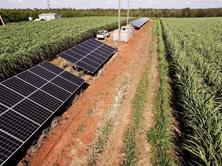
Sub-Components
› Mapping of ownership of all agricultural and livestock holdings and current status of their irrigation facilities › Review of abstraction volumes from each borehole › Establishment of needs for solar irrigation and borehole systems › Preparation of design brief for boreholes / irrigation systems › Development of procurement and deployment plan › Maintenance plan › Benchmark: US$3,000 per system41 › Actual: US$90,000 based on max 30 systems › Funding (eqpt, installation): › IFI/ donor finance › Lower costs for farmers where current system is on grid › Consistent service provision for farmers with no powered irrigation › Reduced carbon emissions associated with farming sector › Partner with regional / county government to coordinate activities › Partnering with local equipment specialists to determine solutions › Maintenance - capacity building programme to ensure continued operation of systems › Maintenance - responsibility of individual farmers
Estimated Costs Impacts (Benefits) Delivery Mechanisms Challenges
› Effort needed to obtain comprehensive data on current situation › Funding Data Gaps Time Frame
› Knowledge of current situation › Short to mid-term
Case Study: Grid Alternatives International Program has been helping farmers in Nicaragua with sustainable irrigation solutions for the last five years. One such solution helped the Valle family of Matagalpa. They grew squash, passion fruit and tomatoes on two acres of land to sell at the local market but had trouble making a profit due to high irrigation costs. The monthly electricity bill to run their pump was US$33, but their income was only US$103. Also, the supply quality was poor, meaning they could only irrigate on three days instead of every day. Other expenditure reduced their earnings to US$25 a month. Working with Grid Alternatives and local company Suni Solar, they installed a solar irrigation system. The total cost was US$10,000, but Valle family was only asked to pay US$2,000 which they financed via UNAG, their national agricultural organisation. Two solar panels power a pump that abstracts water from a nearby river into a cement tank and to a gravity fed pole mount system that drips onto the plants. With adequate water supply to the plants, they can now irrigate other crops, including onions, pipian and pasturage, and also raise tilapia. Their monthly electricity bill is now US$3, and their monthly earnings have now increased to US$546.42
41 FAO The benefits and risks of solar-powered irrigation - a global overview (2018), accessed 30th July 2019 http://www.fao.org/3/I9047EN/i9047en.pdf 42 Solar Drip Irrigation Case Study - The Valle Family, accessed 29th July 2019 https://gridalternatives.org/sites/default/files/International%20Valle%20irrigation%20case%20study.pdf
87 ISIOLO URBAN ECONOMIC PLAN
WIDER AREA PROPOSAL Formalise Waste Collection and Segregation
Formalising and integrating the role of the informal sector into Isiolo Town’s waste management system. Introducing source segregation in households and commercial establishments. Encouraging community based organisations to form operational partnerships with private or public waste collectors: › Identifying roles in waste management; › Maintain dialogue and interaction; › Maintaining employment. Develop and implement a smart app / text message system to facilitate town-wide waste collection and segregation.
Sub-Components Estimated Cost Impacts (Benefits)
Formalising the Informal Waste Collection Services ~USD $50 - 100k annually
~USD $50k to develop and implement smart app for town-wide waste collection
Funding: IFI / Donor Finance › Reduced wild dumping of waste and improved sanitation › Provides an increased level of service and engages community and private sector › Improves sanitation and flood and surface water management ability. › Formal employment for waste pickers with adequate wages and health and safety training › Involvement of waste picker organisations to provide support and supervision › Better working conditions for waste sorters › More efficient segregation of recyclables › Higher quality materials which can be sold to recycling brokers › Improved understanding of waste collection and collection days, etc › Introduction of Private
Public Partnership (PPP) into waste collection effort › Support from NGOs, community groups, waste pickers › Employment and training by Isiolo
Municipality or private entity / CBOs › Funding for PPE, collection carts, training and wages for the CBOs, etc › Maintenance responsibility of
Municipal Government

Delivery Mechanisms Challenges
› Non-biodegradable waste is left on the streets as litter › No formal recycling in place › Lack of health and safety systems in place for collecting and sorting waste by informal sector (waste pickers) › Not all residents have smart phones › Provide adequate training and support systems › Convert existing infrastructure › Launch public awareness campaign › Develop smart app system Short-term / Ongoing
Data Gaps Time Frame
Case Study: Developing an Integrated Waste Management System - Kampala, Uganda In Kampala, Uganda, the development of an integrated waste system was prompted by the lack of formalisation in the waste sector. Much of the waste was disposed informally by dumping, burning or burying. Only 55% of the city’s solid waste was officially collected and transported to the city’s landfill by the Kampala Capital City Authority (KCCA). Several standalone Community Based Organisations (CBO) existed offering financial incentives to informal settlements for the collection System, a strategy was developed of recyclable materials, however, the to identify, inform and consult KCCA were not aware of many of these stakeholders; clear objectives and organisations. The KCCA developed measurable targets for education and a new Kampala City Integrated Waste knowledge sharing were created; Management System to improve the activities were undertaken to educate collection, transportation and treatment waste pickers; a new contract was of the city’s waste and incorporate the developed to ensure that new landfill informal sector (predominately the operators would formally integrate landfill pickers and CBOs) as part of an registered waste pickers; and CBOs integrated approach across the waste were encouraged to form partnerships management value chain. As a result with the KCCA in order make the of the Integrated Waste Management System more integrated.
WIDER AREA PROPOSAL Solid waste infrastructure improvements - development of recycling and treatment infrastructure
Developing basic recycling infrastructure. Construction of a simple material recycling facility (MRF) at the landfill to enable informal sector to recycle safely and increase waste awareness and education.
› Determine level of investment and secure funding (IFI, grant, PPP or direct by government); › Engage with informal sector and CBOs (existing Kalundu dumpsite pickers,
Isiolo Taka Youth Group, etc). Development of composting facility for managing organic waste › Develop mechanism for implementing source segregation of organic waste (through waste collection and simple MRF); › Develop mechanism for developing in-vessel composting facility (PPP, funding, grants or direct by government) and identify opportunities / impacts of CDM. Develop the facility and secure / ensure end-markets are available - for recyclate and for compost on agricultural land Develop mechanisms for payment / fees between collectors, Municipality, pickers and recyclate sales.
ECONOMIC DEVELOPMENT PLAN 88
Challenges
› Isiolo has waste being dumped on the road, uncontrolled fires and pollution of surrounding water bodies. › No formal means of treating and disposing of waste. › Limited formal collection mechanisms › Secure markets for recyclates and land / area for the treatment facilities › Obtain funding for treatment infrastructures › Formalise collection process so that waste is sorted and transported to the appropriate facility › Construct concrete slab: short-term › Material Recovery Facility (MRF):
Short / medium-term › In-vessel composting Facility:
Short / medium-term
Data Gaps Time Frame
Sub-Components Estimated Cost Impacts (Benefits)
› Construction of concrete slab on remediated area
› Material
Recovery
Facility (MRF) › USD $250k to USD $1 million
› USD $250k to $750k › Funding:
IFI/ Donor
Finance › Reduced ground and water pollution › Provides area for formalised recycling and waste composting to take place › Creating employment
› Improve community waste awareness › Provides an increased level of service and engages community and private sector › Formalises the sorting process › Employs informal waste pickers › Secures markets to sell the recovered outputs › Provide a safe and regulated environment for waste sorting › Recover and sell recyclable material (e.g. plastics, paper, glass, metals) and receive revenue from sales
› In-vessel composting facility › USD $250k to $500k › Funding:
IFI/ Donor
Finance › Reduced wild dumping of waste and improved sanitation › Can produce usable fertilizer for agriculture › Reduces methane production in the landfill › Diverts organic waste from landfill › Improves local air quality › Provides a sustainable treatment method for fish processing waste Delivery Mechanisms
› Opportunity for collaboration with private sector
› Opportunity for private or public sector to collaborate with informal sector › Would enable wide spread source segregation to be implemented across the Town › Collaboration with recycling facilities to secure markets: locally in Isiolo – paper/ card and possibly plastics; nationally in Nairobi or
Mombasa - metals and plastics
› Opportunity for private or public sector to collaborate with informal sector › Would enable wide spread source segregation to be implemented › Collaboration with farmers to secure local end markets › Collaboration with fish processors to provide treatment for wastes
89 ISIOLO URBAN ECONOMIC PLAN
Case Study: CEMPRE, Brazil - www.cempre.org.br In Brazil, 800,000 waste pickers collect and sort 18% of the recycled waste in the country. In 1992, a group of companies created the Compromissa Empresarial para Reciclagem (CEMPRE) translated to Brazilian Recycling Commitment, which is a non-profit organisation funded by consumer goods corporations, who have partnered to promote recycling and provide safe conditions for waste pickers in Brazil. CEMPRE trains waste pickers, also known as ‘catadores’, through pictures and videos on how to build a business in waste picking and recycling while following health and safety guidelines. The organisation also removes the middle man from the selling transaction in order to allow waste pickers to deal directly with reprocessors and brokers and keep the entire value of the material they collect and sell. Heron In-vessel Composting The Heron IVC is a containerised South African composting technology that takes unwanted food waste and turns it into a soil conditioner. The technology shreds waste to increase its surface area before being mixed and fed into the composting vessel. The temperature of the material in the composting vessel reaches 60 degrees plus. The process reduces the net weight of the incoming feedstock by around 30%. A 24 cubic meter Heron IVC machine costs around Rand1.2 million and can process two tonnes of food waste a day. The plant is currently being effectively utilised in South Africa.
